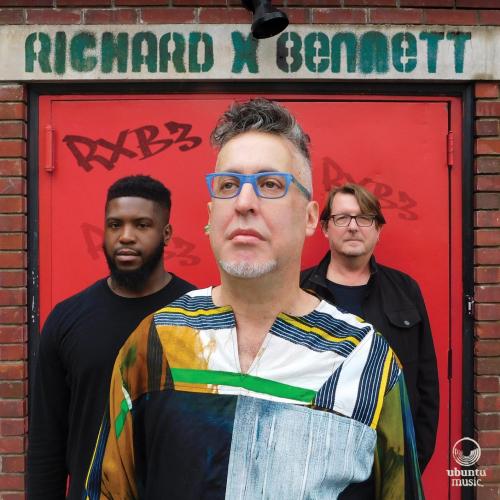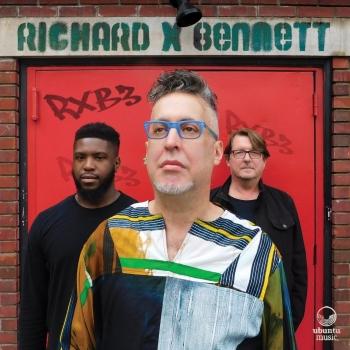
R X B 3 Richard X Bennett
Album Info
Album Veröffentlichung:
2021
HRA-Veröffentlichung:
28.05.2021
Das Album enthält Albumcover
- 1 I Come From the Future (feat. Adam Armstrong & Julian Edmond) 04:34
- 2 This is My Code (feat. Adam Armstrong & Julian Edmond) 04:29
- 3 It's Only July (feat. Adam Armstrong & Julian Edmond) 05:38
- 4 Laughing Lion. (feat. Adam Armstrong & Julian Edmond) 02:33
- 5 One Voice (feat. Adam Armstrong & Julian Edmond) 03:40
- 6 Made From Stone (feat. Adam Armstrong & Julian Edmond) 04:25
- 7 North Atlantic (feat. Adam Armstrong & Julian Edmond) 04:35
- 8 Vape (feat. Adam Armstrong & Julian Edmond) 04:55
- 9 All Organic (feat. Adam Armstrong & Julian Edmond) 02:45
- 10 Plastique (feat. Adam Armstrong & Julian Edmond) 03:44
- 11 The Reckoning (feat. Adam Armstrong & Julian Edmond) 04:22
- 12 Tum Hi Ho (feat. Adam Armstrong & Julian Edmond) 04:33
Info zu R X B 3
The inspirations for Richard X Bennett’s lively work evolve from a wide range of unlikely sources, from contemporary visual art to ancient metaphysics influenced by years performing in India, where he recorded a series of critically acclaimed raga-jazz albums for Times Music, India’s largest record label. At points on RXB3, Richard X Bennett might adopt the triplet pattern of rhythm made popular by leading contemporary rap group Migos, or channel the vibe of pre-LP era Duke Ellington, but ultimately he follows his own muse. His pieces are short takes on the classical ‘theme and variation’, given an edge by deconstructing said themes in a whirlwind of improv, transforming this long-standing technique into ‘theme and destruction’!
Richard X Bennett recorded RXB3 during the lockdown period with long-term collaborator Adam Armstrong on bass and new drummer Julian Edmond on drums, who originally comes from a gospel background. The synergy between the trio is more than apparent on the album. On RXB3, Richard reimagines the trio as a vehicle for his tuneful songs and weighty, poly-rhythmic, groove-centric piano explorations. He explains: “Each song begins as a bespoke piano pattern. The melodies evolve from these patterns, resulting in a multitude of ideas that exist together. I create modern music with a melodic and funky fabric and then tear it apart. My expectation is that you can listen, dance or vibe to this music at your leisure and pleasure. Listen closer and you will hear jazz, contemporary classical and Indian raga elements threaded throughout. The rhythm section has that bounce I like. I met drummer Julian Edmond during the middle of the pandemic and immediately knew that he could raise the music to a new level. He plays a stripped down drum set so there’s more air. Adam Armstrong (bass) has that big jazz sound that roots us in the tradition.”
The songs are all by Bennett with the exception of Tum Hi Ho , which is a Bollywood standard written by Mithoon for the movie, Aashiqui 2. Richard elaborates: “In 2019, I played Tum Hi Ho as a lighter encore for my raga concerts in India. Ballads should be all about the feel. If you’re noticing my technique, then I’ve done something wrong.” Richard X Bennett has adopted a multimedia approach to his art, by creating a series of music video’s (partly inspired by Beyonce’s ‘Lemonade’!) that conjure up a range of moods from the comic to the abstract that perfectly compliment his musical endeavours.
Richard X Bennett has released music on Ropeadope, Times Music and now Ubuntu, fast growing in both repertoire and reputation as one of the hottest jazz labels of recent times. Martin Hummel, Director of Ubuntu Music, gives his perspective on the Label’s latest signing: “Richard’s is, undisputedly, a unique and eclectic breed of the modern piano trio. His compositions are an intoxicating mixture of inviting, seductive melodies which are underpinned by a take-no-prisoners collision of funk-meets-raga-meets-jazz. It’s an addictive musical cocktail for the head, the heart and the feet. We’re only too happy to have Richard join the Ubuntu Music Family.”
Richard X Bennett, piano, melodica
Adam Armstrong, e-bass, acoustic bass
Julian Edmond, drums
Richard X Bennett
From Jimi Hendrix in swinging London to the Art Ensemble of Chicago in the protest-roiled Paris of 1968, groundbreaking American musicians have found an audience and honed their sound abroad before returning home to make their mark. For New York pianist Richard X Bennett, the path to his arresting raga jazz repertoire runs through India, where he’s recorded a series of acclaimed albums for the nation’s largest record label (and several classical labels as well).
Though Bennett has spent almost three decades playing a diverse array of music on the New York scene, his two new albums serve as an eye-opening introduction to this bracingly original jazz artist. With his first U.S. albums under his own name slated for release on Ropeadope Records, Bennett’s mesmerizing raga-powered quintet project Experiments With Truth and melodically charged trio session What Is Now announce the emergence of a major voice unlike any other on the American scene.
Both albums feature the dynamic rhythm section tandem of bassist Adam Armstrong and drummer Alex Wyatt, with the Experiments session expanded by Lisa Parrott on baritone saxophone and Matt Parker on tenor and soprano sax. More than the addition of the horns, what sets the two projects apart is the quintet concept, which brings music that Bennett originally conceived and performed with North Indian classical musicians into a jazz context.
Bennett says the quintet’s repertoire is “kind of like Mingus meets raga in the 21st century. This is the first time I’ve brought this music back into jazz instrumentation. I don’t claim to be a raga musician, because first off, the piano isn’t a raga instrument. I’d say it’s raga-based. I like the analogy they use on cooking shows, ‘This is my take on a dosa.’ As a jazz musician, this is my take on raga,” the vast vocabulary of melodic structures, or modes, upon which classical Indian music is based.
Experiments With Truth opens with “The Fabulist,” a long, persuasively surging piece based on a particularly ancient raga (raga malkauns). With the horns playing a thick unison line, the piece generates galloping momentum, building on the entrancing melodic refrain. “Portrait in Sepia” feels like an Ellingtonian tone poem by way of Calcutta, opening with an ominously swaying cadence designed for Parrott’s brawny bari.
The album’s centerpiece is the two-movement “Durga Suite,” which evokes dual but very different aspects of the multifarious warrior goddess Durga (also known as Devi and Shakti). The title track, which borrows its name from the Mohandas K. Gandhi’s autobiography The Story of My Experiments with Truth, is a stimulating and increasingly wild piece inspired by the early morning raga ramkali. Rather than indicating delusions of grandeur on the part of the composer, the purloined title is a trickster’s confession for a self-invented artist navigating between musical realms.
Bennett credits the combustible chemistry between saxophonists Lisa Parrott and Matt Parker with energizing the raga project. Rather than writing out the ragas, he presents it as a regular tune, albeit one with unusual notes for a Western ear. Parrott’s affinity for Ornette Coleman’s music provides a trenchant point of entry.
“Harmolodics have a certain commonality with raga in the way they deal with melody. She’s a melodic improviser, and Matt is our wild man. His notes slide and glide, like Bismillah Khan. I love ’em both. They have such power.”
The trio album What Is Now displays a very different facet of Bennett’s musical expression. He is featured as a bold, percussive instrumentalist and as a composer of themes that beg for lyrics. The album's mood, energy, and tone range from the tender opener "Vital Grace" to the afro-pop "Go Against the Tide," from the sanctified sway of "Sefrou Soul" to the cinematic scope of "Bittersweet Success." The only ringer is a doo-wop arrangement of "Over the Rainbow."
Since moving to New York, Bennett has thrived working in a wide array of contexts. Today Bennett also works with Honk & Tonk, a "N.O.L.A. meets Noir" duo with fellow Ropeadope artist, saxophonist Michael Blake, and composes for modern dance, most recently a piece for the Alvin Ailey Company performed at the Essence Festival in New Orleans. He introduced his Indo-jazz concept on the 2009 solo album Ragas on Piano (Dreams Entertainment), and expanded the instrumentation with bass and tabla on 2011’s Raga and Blues (Mystica Music). Picked up by Times Music, India’s biggest label, he released 2013’s critically hailed New York City Swara, and followed up on the label with the 2015 duo album Mumbai Masala with Hindustani vocalist Dhanashree Pandit Rai.
In many ways Bennett’s raga jazz flows from his affinity for vocals, and he’s honed his music in Mumbai, a metropolis known for its masterly singers. While many jazz musicians drawn to classical Indian music delve into the intricate rhythmic cycles, he’s drawn inspiration from the extended melodic lines improvised by singers.
“I was always interested in minimalism,” Bennett says. “The blues is like a specific raga, and if you play it academically it won’t sound right. With Indian music, everybody else was doing fusions based on complicated rhythmic figures. I’m much more interested in the melodies.”
Bennett also expresses himself with a singular fashion sense and a generally eccentric attitude. Inspired by Beyonce’s “Lemonade”, he has made short videos for all the songs on both albums with moods ranging from comic to metaphysical.
In Bennett’s hands, the singular synthesis of ancient ragas, minimalism, and jazz make Experiments With Truth a unique accomplishment. Add his consistently compelling trio session What Is Now into the mix and there’s an incontrovertible case for Bennett’s ascension into jazz’s top ranks.
Dieses Album enthält kein Booklet










